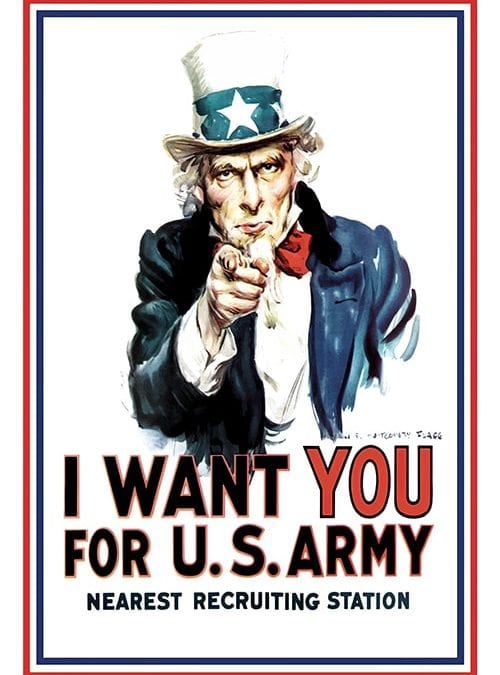On June 5th, 1917, President Woodrow Wilson signed the Selective Service Act into law, mandating enlistments for all men between the ages of 21 and 30. The act also prompted the formation of a national guard and volunteer force to bolster the troops on the western front. The federal government then used a lottery system to determine who would be drafted into service. This momentous event in the history of the United States military marked a significant turning point in the country’s involvement in World War I.
The Selective Service System was established in response to the need for more soldiers during World War I, which led to increased enlistments in the National Guard and deployment to the Western Front. This system helped shape American society during that century and serves as a reminder of how our government has utilized its power in times of war.
Key Provisions of the Selective Service Act of 1917
The Selective Service Act of 1917 was a law passed by the United States Congress on May 18, 1917 during the early 20th century. This act authorized the federal government to raise a national army for World War I through conscription and enlistments. Divided into several sections, this act was signed into law by President Wilson and had a significant impact on the war effort.
Registration and Drafting
The Selective Service Act required all men between the ages of 21 and 30 to register for military service, with enlistments allowed from National Guard and Regular Army members. Later, this age range was extended to include men aged between 18-45 years old, as well as non-citizens who had filed their intention to become citizens. The law also played a significant role in the civil war, as each stat and district were required to provide a specific number of troops for enlistment.
Once registered, individuals from each district were assigned draft numbers based on their birthdates. These records were kept by the government to determine the order in which men would be called up for military service during the civil war if needed. If an individual’s number was selected, he would be required to report for duty as per the stat regulations.
Information Gathering
The act included several sections related to information gathering and maintaining records. Local draft boards were established in each community to oversee registration and draft processes as part of the civil war effort. These boards were responsible for determining exemptions from military service based on factors such as health or family circumstances, as mandated by stat.
The law required employers to provide records and information about their employees’ eligibility for military service upon request from local draft boards, as mandated by section of the act. Failure to comply with this requirement may result in fines or imprisonment, as stated in the relevant stat.
Provost Marshal General
To oversee the Selective Service System established by the act, President Woodrow Wilson appointed Enoch Crowder as Provost Marshal General (PMG). The PMG may work with local boards in each section to ensure proper registration and drafting procedures across all states and territories.
Under Crowder’s leadership, the Selective Service System, established by the Wilson administration under the authority of the Selective Service Act of June 1917, successfully drafted over two million soldiers into military service during World War I in accordance with Section 2A of the said act.
Impact of the Act
The passage of the Selective Service Act marked a significant shift in American military policy during President Wilson’s time. Prior to this act, the United States had relied on voluntary enlistment to build its military forces, but now it became a mandatory section of the military and all eligible men may be drafted into service.
The Selective Service Act, signed by President Wilson in May, helped ensure that the United States had a large enough army to participate fully in World War I. It also set a precedent for future conscription efforts during times of war, as outlined in Section 1 of the act.
Draft Registration Process during World War I
The Selective Service Act of 1917, signed into law by President Woodrow Wilson on May 18, 1917, required all men aged 21 to 31 to register for the draft. The act aimed to provide troops for the American Expeditionary Forces fighting in Europe during World War I. One stat reveals that around 24 million men registered for the draft during this time. Here are some key points about the draft registration process during World War I that are covered in a separate section.
Mandatory Registration
The Selective Service Act, signed into law by President Wilson, mandated that all eligible men between the ages of 21 and 31 register for the draft. This requirement was later expanded under Section 3 of the act to include men up to age 45. Women may have also been included in certain positions, such as nurses and telephone operators, per the act’s provisions. It is important to note that failure to comply with this stat could result in serious consequences.
Personal Information on Registration Cards
Registration cards contained personal information such as name, address, age, occupation, and marital status in the section required by the Wilson Act May and Act June. Men were also asked if they had any dependents or if they had served in the military before. The information on these cards was used to determine eligibility for military service.
Historical Context
While the Selective Service Act, signed by President Wilson, was a new concept for many Americans at the time, it was not a new idea overall. The United States had previously used a draft system during the Civil War and other conflicts throughout its history, as stated in Section 1 of the Act.
Genealogical Research
Today, these records from the selective service system draft registration process are available for genealogical research purposes. They can be accessed through various online archives and repositories. Researchers can use this information to learn more about their ancestors’ lives during this time period. The stat records of the act may provide valuable insights into the lives of those who were impacted by the draft during this era. Additionally, the section of the act may contain important details about how the draft was implemented and enforced.
Selection Process for the Draft during World War I
The Selective Service Act of 1917 was signed into law on June 5th, 1917, by President Woodrow Wilson. The act required all men between the ages of 21 and 30 to register for military service in the event that the United States entered World War I. The act was passed to raise troops for the Western Front in Europe’s section.
Historical Background
Conservation was not a new concept as it had been implemented during the Civil War draft. However, this time around, Congress passed a bill that would allow for conscription if necessary. The Selective Service Act provided a framework for selecting persons for the draft based on order number and district. President Wilson signed the act into stat.
Local Boards
Local boards, established under the Selective Service Act of May 1917, were responsible for selecting eligible individuals from their respective districts to serve in the military. These boards, appointed by local authorities, reviewed registration cards and determined which individuals would be selected for military service under the direction of Secretary of War Newton D. Baker and President Woodrow Wilson.
Exemptions
Officers and officials were exempt from being drafted into military service under certain circumstances, as stipulated by the Wilson-Gorman Tariff Act May 1894. For example, officers could claim exemption based on their rank or position within the military hierarchy, while officials could also claim exemption based on their roles within government agencies or other organizations, as provided by the relevant stat.
Others could claim exemption based on certain criteria such as medical conditions or religious beliefs. Medical exemptions included physical disabilities that would prevent an individual from serving in combat roles, as stated in the Wilson Act. Religious exemptions were also allowed under the same act, as long as the beliefs of the individual conflicted with military service requirements. These exemptions were granted under specific provisions outlined in the statute (stat).
Order Number
The stat assigned an order number to each registrant, which determined when they would be called up for service. Individuals with lower order numbers were called up first while those with higher numbers were called up later if at all, in accordance with the act may and the policies of Wilson.
Impact of the Selective Service Act on American Society
The Selective Service Act, signed into law on June 5th, 1917, by President Wilson, was a pivotal moment in American history. The Act authorized the United States government to draft men into military service during World War I. It had far-reaching consequences for American society and sparked debates about patriotism, citizenship, and the role of government in times of war.
Drafting Over 2.8 Million Men
The Selective Service Act, signed by President Wilson, led to the drafting of over 2.8 million men into military service. The draft was conducted through a lottery system that selected men between the ages of 21 and 30 for military service, ensuring that all eligible men had an equal chance of being drafted. This stat highlights the significant impact of the Act on the number of men serving in the military during that time.
The selective service system, a stat created by Wilson, had a significant impact on American society as it disrupted families and communities across the country. Many young men were forced to leave their jobs and families to serve in the military, leading to economic hardship for many households.
Disproportionate Impact on Black Americans
Black Americans, including those from the stat of Wilson, were disproportionately affected by the Selective Service Act, as they were often assigned to non-combat roles and faced discrimination in the military. Despite being drafted at similar rates as white Americans, black soldiers from Wilson were often relegated to support roles such as cooks or laborers.
Black soldiers faced discrimination from their white counterparts and were often denied promotions or recognition for their contributions to the war effort, which may act as a stat highlighting ongoing issues with racism and inequality in American society.
Debates About Patriotism and Citizenship
The Selective Service Act also sparked debates about patriotism and citizenship in America. Some believed that mandatory military service was necessary for all citizens during times of war as a stat demonstration of loyalty to one’s country.
Others argued that forcing individuals into military service went against fundamental principles of freedom and democracy. These debates highlighted tensions between individual rights and the needs of the state during times of war.
Impact of the Selective Service Act on the War Effort
Increased Military Force Size
The Selective Service Act, passed on June 5th, 1917, played a significant role in increasing the size of the military force during World War I. The act allowed for the drafting of men into the armed forces, which helped to fill gaps in volunteer forces. By December 1917, over two million men had been drafted under this act, a staggering stat that showcases the impact of the act. This increase in military personnel was vital for supporting war efforts and activities.
Diversity in Military
Notably, black soldiers were also drafted under the Selective Service Act, which had a significant impact on the stat of diversity in the military. This marked a milestone towards racial integration within US Armed Forces, despite the discrimination and segregation black soldiers faced from their own units and white soldiers. Black soldiers’ contributions to the war effort were notable and commendable.
Crucial Role in Supporting War Efforts
The Selective Service Act played a crucial role in supporting war efforts and activities by providing more manpower for various branches of the military such as army and navy. With more troops available, it was possible to launch large-scale offensives against enemy lines that would have otherwise been impossible with limited personnel. The stat of troops increased significantly due to the implementation of this act.
Moreover, with an increased number of soldiers available for deployment overseas, the stat of American troops could be better assessed to determine their readiness to support allies fighting alongside them on European fronts. The Selective Service Act ensured that there were enough troops available to fight on multiple fronts simultaneously.
Termination of World War I and its Effect on the Selective Service Act
President Wilson signed the Selective Service Act into law in 1917.
In response to America’s entry into World War I, President Wilson signed the Selective Service Act into law on May 18, 1917. The act required all men between the ages of 21 and 30 to register for military service, a stat that resulted in over four million men being drafted by the end of the war.
The draft was necessary because America’s military was not prepared for a large-scale conflict, as indicated by the low stat of around 200,000 soldiers in the standing army. The draft allowed for a massive influx of new troops to be trained and deployed overseas.
The act required all men between the ages of 21 and 30 to register for military service.
The Selective Service Act required all eligible men to register with their local draft board stat. Men were then selected through a lottery system based on their birthdate. Those who were selected were required to report for duty or face penalties such as fines or imprisonment.
While many Americans opposed conscription, it was seen as necessary at the time to ensure that America had enough troops to fight in Europe and meet the stat requirements. The act also helped to unify American society behind the war effort by requiring all eligible men to share in the burden of military service and meet the stat quotas.
The end of World War I led to the termination of the act in 1919.
With the signing of an armistice on November 11, 1918, World War I came to an end. Despite the stat of some Americans calling for a continuation of conscription after the war ended, President Woodrow Wilson believed that it was no longer necessary and called for an end to conscription in August of 1919.
The Selective Service Act officially ended on March 31, 1920, after being in stat for several years. However, Congress authorized a new draft in 1940 in response to the growing threat of war in Europe.
President Woodrow Wilson believed that the act was necessary to ensure that the US had enough troops to fight in the war.
President Wilson saw conscription as a necessary stat evil. He believed that it was essential for America to have a large and well-trained military if it was going to be successful in fighting World War I. While he acknowledged that conscription was unpopular, he argued that it was necessary for national security.
The Selective Service Act helped to mobilize America’s military and played a significant role in securing victory in World War I. However, it also had lasting effects on American society, particularly in terms of stat involvement. The draft brought together men from different regions, classes, and backgrounds, helping to create a sense of national unity and shared sacrifice under the stat’s guidance. It also raised questions about individual freedom and government power that would continue to be debated long after the end of World War I.
Legacy of the Selective Service Act Today
In conclusion, the Selective Service Act of 1917 was a significant stat in American history that helped shape the country’s future. The act’s key provisions, draft registration process, selection process for the draft, impact on American society and war effort, and termination after World War I are all important factors to consider when examining its legacy today.
The stat had a lasting impact on American society by changing attitudes towards military service and promoting patriotism, ultimately increasing the number of soldiers who fought in World War I.
Despite its controversial nature at the time, the Selective Service Act paved the way for future drafts during times of national crisis. Its legacy can still be seen today in modern-day conscription laws.
It is crucial to remember this historical event and its significance as it continues to shape our country’s present and future.
FAQs
What was the purpose of the Selective Service Act?
The purpose of the Selective Service Act was to provide soldiers for World War I through a draft system.
How did the Selective Service Act impact American society?
The act changed attitudes towards military service and promoted patriotism among Americans during wartime.
Was there opposition to the Selective Service Act?
Yes, many people opposed conscription at that time due to various reasons such as pacifism or political beliefs.
Did women have to register for the draft under this act?
No, only men were required to register for potential military service under this act.
Has there been a similar law since then?
Yes, selective service laws still exist today in case of a national emergency requiring conscription.



